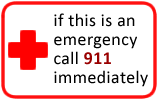Cough
Cough
Does this describe your child's symptoms? |
Definition
Causes
Sputum or Phlegm
Return to School
|
If not, see these topics
|
When to Call Your Doctor |
Call 911 Now (your child may need an ambulance) If |
|
|
|
Call Your Doctor Now (night or day) If |
|
|
|
Call Your Doctor Within 24 Hours (between 9 am and 4 pm) If |
|
|
|
Call Your Doctor During Weekday Office Hours If |
|
|
|
Parent Care at Home If |
|
|
HOME CARE ADVICE FOR COUGH |
Reassurance:
Coughs are a normal part of a cold.
Coughing up mucus is very important for protecting the lungs from pneumonia.
We want to encourage a productive cough, not turn it off.
Homemade Cough Medicine:
Goal: reduce the irritation or tickle in the throat that triggers a dry cough.
AGE 3 months to 1 year: Give warm clear fluids (e.g., water or apple juice) to treat the cough. Amount: 1-3 teaspoons (5-15 ml) four times per day when coughing. Avoid honey until 1 year old.
AGE 1 year and older: Use HONEY ½ to 1 teaspoon (2-5 ml) as needed as a homemade cough medicine. It can thin the secretions and loosen the cough. (If not available, can use corn syrup.)
AGE 6 years and older: Use COUGH DROPS to coat the irritated throat. (If not available, can use hard candy.)
Non-Prescription Cough Medicine (DM):
Non-prescription cough medicines are not recommended. (Reason: no proven benefit for children and not approved for children under 4 years old) (FDA 2008)
Honey has been shown to work better for coughs.
If you decide to use a cough medicine from your drugstore and your child is over age 4 years, choose one with dextromethorphan (DM). It's present in most non-prescription cough syrups.
Indication: Give only for severe coughs that interfere with sleep, school or work.
DM Dosage: See Dosage table. Give every 6 to 8 hours for severe coughs that interfere with sleep, school or work.
Coughing Spasms:
Expose to warm mist (e.g., foggy bathroom).
Give warm fluids to drink (e.g., warm water or apple juice) if over 3 months of age.
Amount: If 3 months to 1 year of age, give warm fluids in a dosage of 1-3 teaspoons (5-15 ml) four times per day when coughing. If over 1 year of age, use unlimited amounts as needed.
Reason: both relax the airway and loosen up the phlegm
Vomiting: For vomiting that occurs with hard coughing, reduce the amount given per feeding (e.g., in infants, give 2 oz. less formula) (Reason: Cough-induced vomiting is more common with a full stomach).
Fluids: Encourage your child to drink adequate fluids to prevent dehydration. This will also thin out the nasal secretions and loosen the phlegm in the airway.
Humidifier: If the air is dry, use a humidifier (reason: dry air makes coughs worse).
Fever Medicine: For fever above 102° F (39° C), give acetaminophen (e.g., Tylenol) or ibuprofen.
Avoid Tobacco Smoke: Active or passive smoking makes coughs much worse.
Contagiousness: Your child can return to child care or school after the fever is gone and your child feels well enough to participate in normal activities. For practical purposes, the spread of coughs and colds cannot be prevented.
Extra Advice- Antihistamines for Allergic Cough:
Antihistamines can bring an allergic cough and nasal allergy symptoms under control within 1 hour.
Benadryl or Chlorpheniramine (CTM) products are very effective and no prescription is needed.
They need to be given every 6 to 8 hours (See Dosage table).
Expected Course:
Viral bronchitis causes a cough for 2 to 3 weeks.
Sometimes your child will cough up lots of phlegm (mucus). The mucus can normally be gray, yellow or green.
Antibiotics are not helpful.
Call Your Doctor If:
Difficulty breathing occurs
Wheezing occurs
Cough lasts over 3 weeks
Your child becomes worse
And remember, contact your doctor if your child develops any of the "Call Your Doctor" symptoms.
Updated:
March 22, 2017



